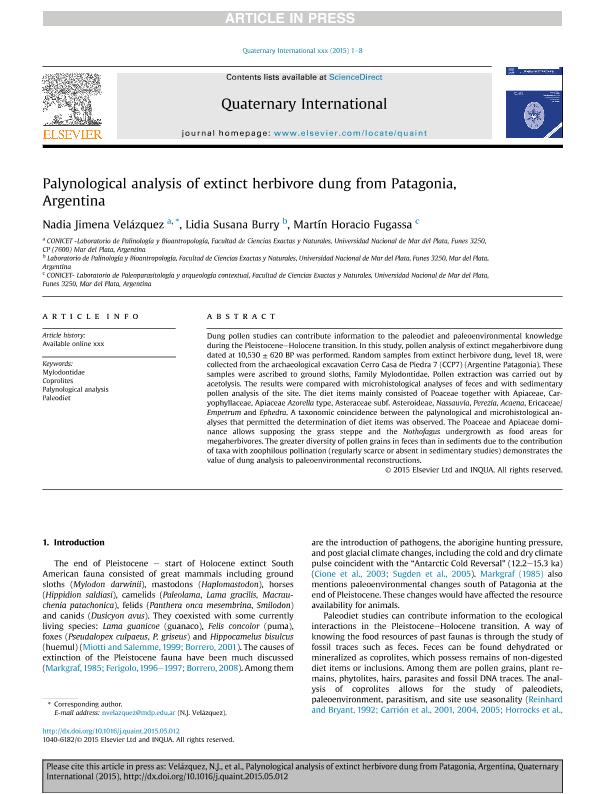Mostrar el registro sencillo del ítem
dc.contributor.author
Velázquez, Nadia Jimena

dc.contributor.author
Burry, Lidia Susana

dc.contributor.author
Fugassa, Martín Horacio

dc.date.available
2018-06-26T17:43:05Z
dc.date.issued
2015-05
dc.identifier.citation
Velázquez, Nadia Jimena; Burry, Lidia Susana; Fugassa, Martín Horacio; Palynological analysis of extinct herbivore dung from Patagonia, Argentina; Pergamon-Elsevier Science Ltd; Quaternary International; 377; 5-2015; 140-147
dc.identifier.issn
1040-6182
dc.identifier.uri
http://hdl.handle.net/11336/50111
dc.description.abstract
Dung pollen studies can contribute information to the paleodiet and paleoenvironmental knowledge during the Pleistocene-Holocene transition. In this study, pollen analysis of extinct megaherbivore dung dated at 10,530 ± 620 BP was performed. Random samples from extinct herbivore dung, level 18, were collected from the archaeological excavation Cerro Casa de Piedra 7 (CCP7) (Argentine Patagonia). These samples were ascribed to ground sloths, Family Mylodontidae. Pollen extraction was carried out by acetolysis. The results were compared with microhistological analyses of feces and with sedimentary pollen analysis of the site. The diet items mainly consisted of Poaceae together with Apiaceae, Caryophyllaceae, Apiaceae Azorella type, Asteraceae subf. Asteroideae, Nassauvia, Perezia, Acaena, Ericaceae/. Empetrum and Ephedra. A taxonomic coincidence between the palynological and microhistological analyses that permitted the determination of diet items was observed. The Poaceae and Apiaceae dominance allows supposing the grass steppe and the Nothofagus undergrowth as food areas for megaherbivores. The greater diversity of pollen grains in feces than in sediments due to the contribution of taxa with zoophilous pollination (regularly scarce or absent in sedimentary studies) demonstrates the value of dung analysis to paleoenvironmental reconstructions.
dc.format
application/pdf
dc.language.iso
eng
dc.publisher
Pergamon-Elsevier Science Ltd

dc.rights
info:eu-repo/semantics/openAccess
dc.rights.uri
https://creativecommons.org/licenses/by-nc-nd/2.5/ar/
dc.subject
Coprolites
dc.subject
Mylodontidae
dc.subject
Paleodiet
dc.subject
Palynological Analysis
dc.subject.classification
Paleontología

dc.subject.classification
Ciencias de la Tierra y relacionadas con el Medio Ambiente

dc.subject.classification
CIENCIAS NATURALES Y EXACTAS

dc.title
Palynological analysis of extinct herbivore dung from Patagonia, Argentina
dc.type
info:eu-repo/semantics/article
dc.type
info:ar-repo/semantics/artículo
dc.type
info:eu-repo/semantics/publishedVersion
dc.date.updated
2018-06-26T13:44:36Z
dc.journal.volume
377
dc.journal.pagination
140-147
dc.journal.pais
Estados Unidos

dc.description.fil
Fil: Velázquez, Nadia Jimena. Universidad Nacional de Mar del Plata. Facultad de Ciencias Exactas y Naturales. Departamento de Biología. Laboratorio de Palinología y Bioantropología; Argentina. Consejo Nacional de Investigaciones Científicas y Técnicas; Argentina
dc.description.fil
Fil: Burry, Lidia Susana. Universidad Nacional de Mar del Plata. Facultad de Ciencias Exactas y Naturales. Departamento de Biología. Laboratorio de Palinología y Bioantropología; Argentina. Consejo Nacional de Investigaciones Científicas y Técnicas; Argentina
dc.description.fil
Fil: Fugassa, Martín Horacio. Universidad Nacional de Mar del Plata. Facultad de Ciencias Exactas y Naturales. Departamento de Biología; Argentina. Consejo Nacional de Investigaciones Científicas y Técnicas; Argentina
dc.journal.title
Quaternary International

dc.relation.alternativeid
info:eu-repo/semantics/altIdentifier/doi/http://dx.doi.org/10.1016/j.quaint.2015.05.012
dc.relation.alternativeid
info:eu-repo/semantics/altIdentifier/url/https://www.sciencedirect.com/science/article/pii/S104061821500498X
Archivos asociados
